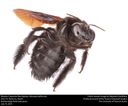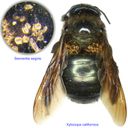California Carpenter Bee
Xylocopa californica
Classification
- Phylum: Arthropoda
- Subphylum: Hexapoda
- Class: Insecta
- Order: Hymenoptera
- Family: Apidae
- Subfamily: Xylocopinae
- Genus: Xylocopa
- Species: californica
Pronunciation
How to pronounce Xylocopa californica: //ˌzaɪlɵˈkoʊpə ˌkælɪˈfɔrnɪkə//
These audio files are automatically generated. While they are not always 100% accurate, they are a good starting point.
Images






Summary
The California carpenter bee is a species of carpenter bee found in western North America, known for its all-black body with bluish reflections and significant pollination role in various ecosystems.
Physical Characteristics
Typically large carpenter bee, 20-25 mm long; all black with bluish/greenish reflections; male has lighter markings on the pronotum; the head is larger and thicker than the thorax.
Identification Tips
Compare other Carpenter bees in range, such as X. varipuncta. Female carpenter bees have bigger heads than males with more narrow heads. The male typically has light hairs on the pronotum and abdominal segments.
Habitat
Forests and nearby meadows; native to desert regions.
Distribution
Found in California, Nevada, Oregon, Washington, Utah, Arizona, New Mexico, Texas, and Northwestern Mexico, with outlying records in Montana, Kansas, and Louisiana.
Diet
Prefer nectar and pollen, specifically from creosotebush (Larrea tridentata) and mesquite (Prosopis glandulosa).
Life Cycle
Life cycle includes both an adult phase that forages and a larval stage in nests dug in wood or plant stems.
Reproduction
Females only mate once in their lifetime; mating behaviors include hovering and territorial displays by males.
Predators
Ladder-backed woodpecker (Dendrocopos scalaria); bee fly (Anthrax simson) parasitizes nests. Honey bee (Apis mellifera) may negatively impact populations.
Ecosystem Role
Agriculturally beneficial pollinators of diverse plant species including California chaparral and woodland.
Health Concerns
May be infected with the fungus Ascosphaera apis after visiting infected plants but is not a natural host.
Similar Taxa
Misconceptions
Mistakenly perceived as aggressive; do not have a stinger.
Tags
- California Carpenter Bee
- Xylocopa californica
- pollinator
- Hymenoptera
- endothermic insect